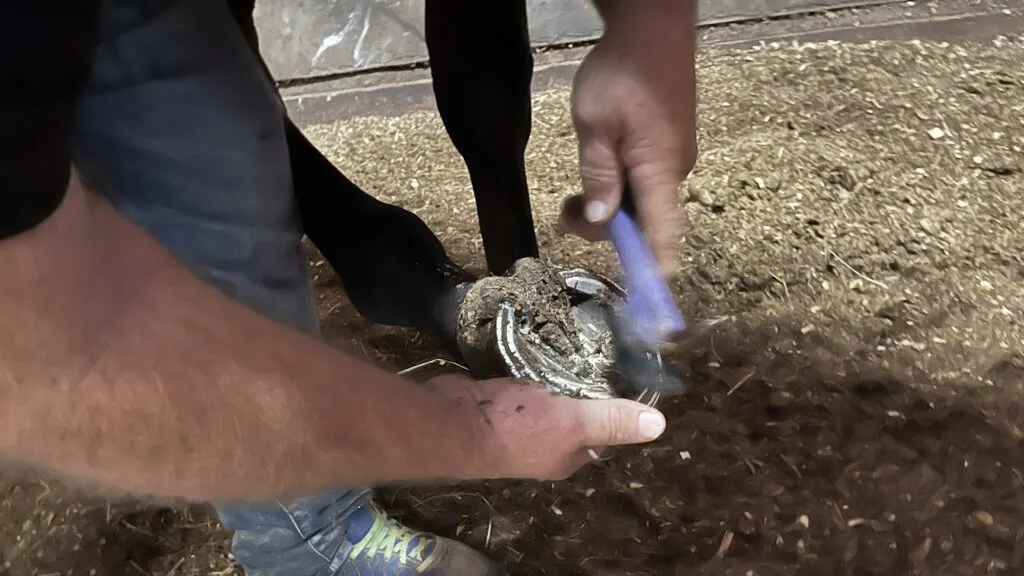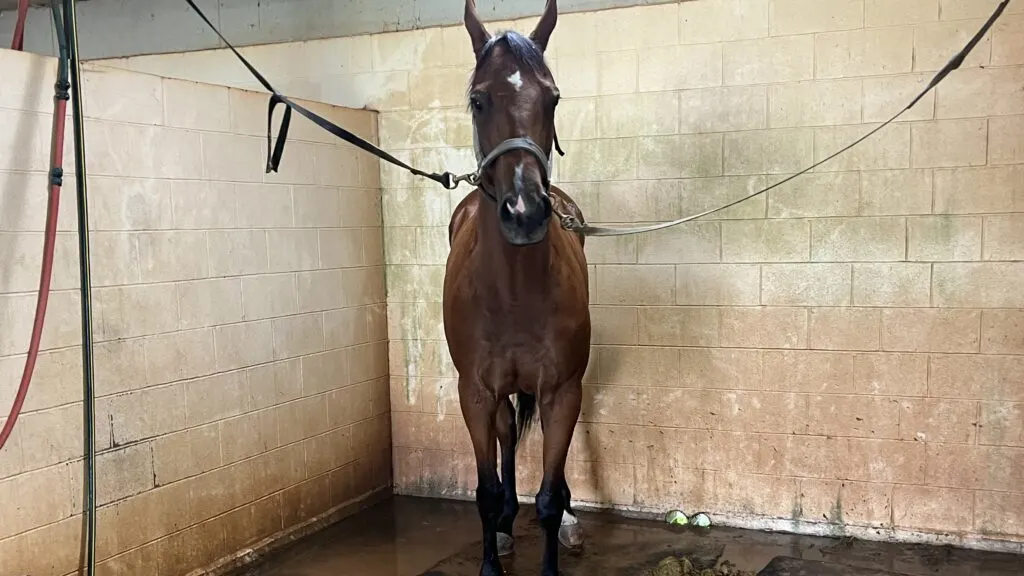Last updated: January 18, 2023
Any links on this page that lead to products on Amazon are affiliate links and I earn a commission if you make a purchase. Thanks in advance – I really appreciate it!
When my grandson visits, he helps groom our horses. He recently asked me to teach him how to care for his horse’s hooves, so I did, and I also decided to put some information together for other new horse owners.
We groom our horses every day, including caring for their hooves. Thorough daily grooming helps keep horses healthy and allows owners to detect potential problems before they turn into severe conditions. An essential aspect of a horse’s daily grooming is taking care of its hooves.
Hoof care is essential, given that horses’ feet go through quite a bit of pounding, especially if they are frequently involved in show events or competitions. To prevent injury in your horse, you must know the basics of caring for their hooves.
To properly care for your horses’ feet, a good hoof care kit is essential and should include a pick, nippers, knife, puller, spreader, rasp, and clinchers.

The Basics of Caring for Your Horses Hooves
Daily inspection
I highly recommend you inspect the horse’s feet at least once daily, if not every other day. During the inspection, examine the hoof’s structural integrity to check for damages or abnormalities.
Horses’ feet are highly susceptible to bacterial and fungal infections. Most of these infections are abscess based and are typically easy to control with proper foot maintenance. We own Thoroughbreds, and they are known for having bad feet, so we pay special attention to their care.
One such area to check is the frog, which, as mentioned above, could be susceptible to abscesses, especially when the area is wet or moist. You should also check the hooves’ wall to determine if it is time for you to do some trimming and check if there is any dirt or grime stuck in it.
The underside of the hooves is a commonly neglected area that most owners fail to check. Remember to check the bottom of the feet as mud or other impurities can lodge in them, creating pain or discomfort to the horse when they move around.
6 essential steps to care for your horse’s hooves.
I find it best to have a routine when grooming our horses and approach each time in the same manner, tie the animal in the same location and start with the same foot. Having a routine helps your horse stay calm and allows it to enjoy the process.
Approaching the horse
When working with horses, it’s essential to approach the animal correctly. Horses are large animals and can hurt you. It’s possible a horse might give you a kick when you unwittingly spook it by approaching it from the rear or exhibit sudden movements that might trigger the horse to produce an unexpected reaction.
For starters, always ensure you walk towards the horse from the front so it can see you. As you approach the horse, speak to it and call out its name to ensure they know you are coming towards them.
If you notice that the horse is very jittery, I try to calm the horse before grooming by petting its neck and letting the animal relax. Once the horse appears to be comfortable and at ease, you can begin work on the hooves!
The YouTube video below explains how to approach a horse, pick its feet, and provides some other useful information.
Secure your horse before you begin grooming.
Your horse must be secured before you begin working on its feet; I typically use a hitching post outside the barn. But sometimes, we take care of their feet at the wash rack and secure them with cross ties.

I prefer to tie a horse in a location that gives it a wide field of vision. Tying horses in a cramped, isolated spot increase their anxiety; remember they are prey animals, and their instincts are to be aware of their surroundings.
Your goal is to reduce their stress and decrease the risk of injury to you and your horse.
Approaching the foot
Once you have the horse secured, don’t go straight to the foot just yet, as it might still trigger a response from the horse. What you should do instead is position yourself next to the front legs.
Always stand next to the horse’s shoulder, facing the opposite direction of the horse; this keeps you out of harm’s way if the horse decides to kick. And remember which side you begin with and follow the same routine each time.
Lifting the horse’s foot

Once you are comfortably in place, squeeze the back of the horse’s lower leg to signal that they should lift the hoof up. Note that you should not apply excessive pressure because this could trigger the horse to kick. Once the foot is lifted, you have two options:
- Hold the hoof while the other hand uses a pick to pry away debris.
- Place the hoof in between your thighs.
I place the hoof’s foot between my legs and squat a little. With their foot between my legs, I have more control when I’m picking the horse’s hoof. Picking your horses’ hooves keeps bacterial growth down from dirt and debris caught in their feet’ crevices.
Picking on the hooves
Once you’ve gotten your horse’s foot in position, hold the pick in a downside position such that the hook is facing downwards. This will afford you more control over the picking process.
Note that you should not use excessive force when picking out the debris because you might accidentally hurt the horse. Just take your time and work out the stubborn debris. First, knock off the big stuff from the bottom of the horse’s foot.
Once you have cleared out the larger debris, start to work on the frog. The frog is the part of the hoof that’s shaped like a V and is typically neglected by owners.
To start picking around the frog, move the pick down from the back of the hoof right to the front. Moving in this direction helps to dislodge any stubborn debris that’s tough to clear out. Last but not least, after you have cleared out most of the trash, use a brush to remove the smaller chunks!
Hoof aftercare
Once you are done with the picking, spray the hooves down to wash away the dirt on the hooves’ exterior and apply conditioner to add a layer of protection to it. A good conditioner will help to prevent cracking and, at the same time, improve the flexibility of the hooves too.
Amazon sells Farnam RainMaker, which I find works well for our horses; however, most hoof conditioners provide sufficient protection. You can click here to read Amazon customer reviews to learn what other horse owners think about it.

Other points to note when caring for your horse’s hooves
Of course, while we will need to monitor the hooves’ condition and clean it regularly, we can also help care for horses’ feet in other ways.
Clean and dry bedding is essential.
Proper care of your horse’s hooves includes keeping your horse in an area that is clean and dry. If your horse is stall-kept, make sure it has appropriate bedding material.
When a horse stands in moisture, it traps wet material in the crevices of the bottom of its feet. This material deteriorates and creates bacteria and fungi. Dry bedding helps alleviate bacteria’s growth; they love wet, warm conditions.
The bacteria can manifest and grow in the horse’s feet, which leads to a condition known as thrush, a bacterial infection. This bacterial infection could cause the frog to be soft and sore, leading to immense pain for the horse if left untreated.
Also, it can produce a foul smell that can easily penetrate the whole stable. To treat this, clean the horse’s bed and apply a topical solution to the affected area.

Trimming of hooves
Domestic horses need their hooves trimmed regularly. How often depends on the ground your horse is kept. Much like wild horses that live in the rough western terrain, horses kept on rough, dry surfaces file their hooves naturally when walking or running and therefore don’t often require trimming.
Adversely, horses kept in soft, lush pastures need their hooves trimmed quite often. If horse hoofs are allowed to grow too long, it weakens the horse’s overall foot and is painful for the horse to walk.
Also, trimming the horse’s hooves removes cracks in the hoof walls, which helps prevent severe hoof conditions that could lead to lameness. For horses without any hoof issues, we trim their hooves ourselves. If you think you’re up to trimming your horse’s hoofs, Amazon sells a decent pair of hoof nippers for under 30 dollars.

How often should hooves be trimmed?
The season influences the frequency at which your horse’s hooves need to be trimmed. During summer months, the hoofs grow faster and typically require cutting every 6 to 8 weeks.
Hooves grow slower in winter, and your horse can go longer between trimmings. As a general guideline, since the hooves’ growth rate differs quite a bit, the feet can be trimmed every 6 to 12 weeks.
If your horse is used at show events or competitions, you need to trim it every four weeks to ensure that the hooves are optimal and look their best.
Ensure optimal hooves balance
When you check your horse’s hooves, you want to ensure they are balanced. Balanced feet can reduce the possibility of the horse suffering from an injury while they are moving around. Typically, there is three optimal hoof profile that the horse can adopt:
- Straight Hoof-Pastern Angle: To achieve this, you should align the pastern to the front of the hoof wall to form a straight line. The alignment of the hoof and pastern help the animal maintain a steady stride.
- Easy Break-Over: This profile is commonly adopted if the horse walks quite a bit, as it helps to ensure that movement is smoother and less impactful. The toe cannot be rounded to get this profile and must adopt a short square profile.
- Adequate Heel Support: For optimal support to the heel, the shoe should extend behind the hoof wall so that there is a larger surface at the heel, which in turn provides support to the horse as it walks.
Diet affects the health of your horses’ hooves.
The type of food that your horse consumes does impact the health of the hooves. I recommend you provide your horse with food containing biotic and fatty acids as it helps enhance the hoof.
Also, it wouldn’t hurt to provide adequate minerals such as zinc and calcium that will help to strengthen the hooves! Commercial hoof supplements are available and can be purchased at most local feed stores.
Amazon sells a variety of hoof supplements, including Farnam Horseshoer’s Secret Pelleted Hoof Supplement Concentrate, which is highly rated. You can click here to go to Amazon’s customer reviews of Farnam’s hoof supplements.
Check shoe condition
Also, check the condition of your horses’ shoes. Shoes can be quickly replaced to avoid problems such as abrasion. If you notice that holes are appearing or the shoes are in poor condition, arrange a re-shoeing appointment at the earliest time possible.
Click the link to read more about horseshoes and how, why, and when horseshoes need to be changed.
Meet Miles Henry
An avid equestrian and seasoned racehorse owner, Miles Henry brings his extensive experience to the equine world, proudly associating with the AQHA, The Jockey Club, and various other equine organizations. Beyond the racetrack, Miles is an accomplished author, having published various books about horses, and is a recognized authority in the field, with his work cited in multiple publications.
🔗 Connect with Miles:
Twitter
Facebook
YouTube: Check out race highlights, horse care tips, and more!

